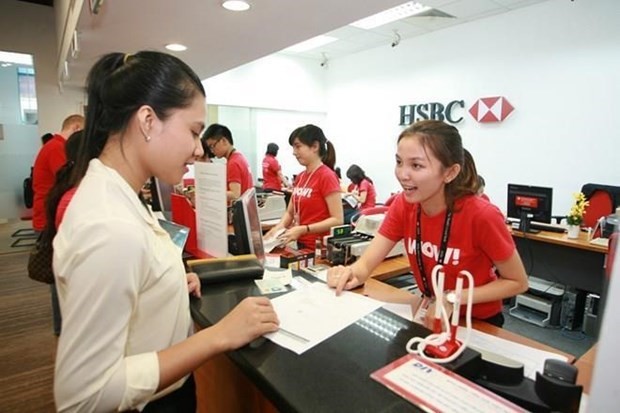
Local banking sector races to implement digital transaction ecosystem
Latest
The local banking sector, currently undergoing drastic restructuring, will have more opportunities to improve its financial transaction capacity as well as learn modern business models and management from UK partners after the UK-Vietnam Free Trade Agreement (UKEVFTA) takes effect, according to banking insiders.
UK banks may set up representative offices, branches, 100% foreign-owned banks and joint ventures with capital contributions not exceeding 50% in Vietnam.
Until 1 August 2025, UK financial institutions may solicitate the approval of Vietnam’s competent authority (State Bank of Vietnam) to buy shares in one joint-stock commercial bank of Vietnam, up to 49% of that enterprise’s chartered capital, except for four commercial banks of which the Government of Vietnam currently holds the majority of equity.
UK investors are also permitted to transfer cross-border financial information and financial data processing. In addition, UK investors can provide cross-border advisory, intermediation, and other auxiliary financial services (including credit reference and analysis, wealth management, acquisitions advice, and corporate strategy).
The UKVFTA was signed on December 29, 2020, and temporarily came into effect on December 31, 2020, before officially starting on May 1, 2022.
Digital transformation is an irreversible trend of businesses in the 4.0 era. Banking and finance is not an exception to that trend, according to banking experts.
According to the State Bank of Vietnam (SBV), at least 95 credit institutions have developed plans for digital transformation. In recent years, the use of banking transactions on digital channels is no longer unknown to the majority of people.
According to experts, the bank's digital transformation journey consists of three steps. The first is digitisation - converting the traditional process to a digital one; the next is digital transformation - digitising each part of business, enhancing customer experience; the last is ultimately digital reinvention - combining technology and digital platforms to generate revenue and results through innovative strategies, products and services.
Most banks are at the third step, so there are already many plans to go further in digital transformation. Therefore, many banks have moved to establish a digital banking ecosystem, from opening accounts to registering, issuing, and managing products. Services such as accounts, credit cards, loans can all be done online.
 |
| Clients make transaction at a HSBC Vietnam transaction office in HCM City. (Photo courtersy of HSBC) |
The percentage of people accessing digital platforms is increasing as Vietnam has a young population structure and a rapidly increasing smartphone usage ratio.
According to Adsota's Vietnam digital advertising market report in July 2020, Vietnam has 43.7 million people using smartphones, or 44.9% of the total population. Vietnam is among the 15 markets with the highest smartphone users globally.
UK-based HSBC opened a full-service branch in Ho Chi Minh City and has taken the lead in implementing digital penetration and new technology solutions which are key focus areas at the bank for both retail as well as corporate customers, according to an HSBC report.
Likewise, on the retail space, HSBC Vietnam has been the first bank in the market to roll out an end-to-end digital journey for onboarding new customers and mobile banking.
HSBC Vietnam has introduced Omni Channel Collections Solution, a dynamic service that supports businesses, especially those who wish to develop e-Commerce, to provide multiple payment options on one single platform.
“We are very proud to be the first international bank and the fifth market in the world for HSBC to launch this innovative solution in Vietnam. This ambitious, holistic and digitalised solution has proved that banks and Fintech companies can flourish in partnership and will help boost digital payments as per the Government of Vietnam’s strategy to encourage cashless transactions,” said Hanh Nguyen, Country Head of Global Liquidity and Cash Management, HSBC Vietnam.
According to Tim Evans, General Director of HSBC Vietnam, two important issues post-Covid-19 to ensure that the financial sector maximises its potential are sustainable finance and digitalisation. The State Bank of Vietnam (SBV) has recently introduced initiatives to support green finance development and digital transformation. It has set a target of 60% of banks having access to green capital and lending to green projects by 2025.
Do Quang Vinh, Member of the Board of Directors, Deputy General Director and Head of Digital Banking Division of SHB, said that digital transformation is considered a long-term project, with items that are highly complex and require coordination between many units.
The bank has transformed customer management to offer a variety of financial solutions as well as applying technology in operations, which help to save time and personnel costs as well as increase productivity.
Nam A Bank said that in 2022 it will continue to focus on increasing investment and applying technology, creating new steps in digital transformation, and continue to perfect the digital banking ecosystem: Robot OPBA, Open Banking and ONEBANK, meeting the needs of transactions anytime, anywhere.
MSB has also cooperated with the world's leading consulting group, Boston Consulting Group (BCG), in implementing the Digital Factory project with an investment of approximately 2 trillion VND (83 million USD).
However, to solve the above problems, banks have to invest up to tens of trillions of dong per year for digital transformation. Vinh said SHB has invested a lot of resources and budget to upgrade Core Banking (core bank), upgrade cards, deploy investment banking, loan origination solutions (LOS), deploy Omni Channel systems and related information technology systems and apply the most modern solutions.
According to Le Anh Dung, Deputy Director in charge of the Payment Department under the SBV, said in the first six months of 2022, non-cash payment transactions increased by 77.2% in quantity and 29.8% in value compared to the same period of last year.
Around 68% of Vietnamese adults have a bank account, and 5.5 million accounts and about 8.9 million bank cards now use the eKYC (electronic Know Your Customer) process.
Speaking at a seminar on digital transformation a few months ago, Governor of the State Bank Nguyen Thi Hong said that the banking industry will strengthen security and safety in electronic payments, effectively implement important payment systems and operate payment intermediary service providers to ensure proper, smooth and safe operation.
She said many domestic banks have 90% of their transactions conducted on digital platforms, surpassing the target of 70% set for 2025. Half of banking services are expected to be digitalised and 70% of transactions will be carried out online by 2025, she noted.




















